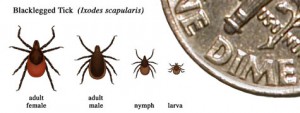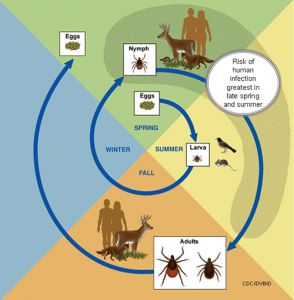
by Sonya R. Justus, PA-C
Portsmouth, NH – Spring is here and with it comes warmer weather! New England’s seasonal climate is one of the region’s most attractive attributes for locals and tourists alike. Unfortunately, this climate is also attractive to the deer tick population, the carriers of Lyme Disease. This year’s mild and dry winter combined with the early very warm temperatures have resulted in ticks being out early and in large numbers.
In coming from the Midwest, I was as unfamiliar with Lyme Disease as New Englanders are with Buckeyes and cow tipping. However, living in the Northeast, most people know someone who has had Lyme disease or whose pet has contracted the disease. With as often as we might have heard about Lyme disease, there continues to be a lot of confusion and misinformation about the disease, the diagnosis, and treatment. If questions or concerns exist about Lyme disease, it is always best to be seen by a medical professional. Hopefully the information in this article will separate some of the truths from the myths when it comes to this often misunderstood disease.

Lyme disease is caused by bacteria known as Borrelia Burdorferi which is transmitted by deer ticks (also known as a black ticks). Deer ticks live in moist, wooded, brushy areas or areas of overgrown grass. The tick can transmit Lyme only if it has been infected with Lyme disease and can transmit when it is either a nymph or an adult. Nymphs are about the size of a poppy seed and often transmit the disease during the spring or early summer (April – July). Adult ticks are a little larger, although still smaller than the tip of a shoelace, and they usually transmit the disease during the autumn months (August – October).
A tick usually needs to be attached for 24 hours in order to transmit Lyme disease; and it usually takes 7-21 days or more before a patient experiences any symptoms of infection. In the earliest phases of infection one might feel tired, have a fever and feel like they have a virus; however the most well-known sign of early infection is the Bull’s-Eye rash. This rash is typically a red center with a clear ring; and another expanding red ring around the outside. This rash, while somewhat easy to identify, only appears in about 50-75% of infected patients. It usually shows up in the area where the individual was bitten, but not always, and the rash will not always look the same. In later stages of infection a patient might have headaches, feel more ill, have heart palpitations, dizziness or have a painful swollen joint. The swollen and painful joints are the symptoms of Lyme disease that we most often see in orthopaedic offices. People will come in thinking that they have an orthopaedic injury or arthritis, but may end up being diagnosed with Lyme disease (after appropriate testing). The important thing to remember is that not all cases of Lyme disease look or present themselves in the same way, and it is always best to be evaluated by a health care professional if you have any of these symptoms and suspect exposure to a deer tick.
The treatment for Lyme disease can be relatively simple and a person should seek medical advice if they have been exposed to a deer tick or its nymph and it has been attached for 24 hours or more. Healthcare providers will evaluate you for the need for a one time preventative dose of antibiotic. Furthermore, if you have a Bull’s eye rash, you should see your doctor, especially if it is believed that you have been exposed to a tick. If the doctor feels that the rash is a Bulls-Eye rash associated with Lyme disease, it is likely that they will be prescribe the patient 14-21 days of antibiotics. If other early symptoms exist such as the fever, headaches, fatigue or muscle aches, and a potential tick or Lyme exposure, a patient should visit their doctor to discuss these symptoms and assess the need for Lyme disease testing. Joint pain and swelling, palpitations, or dizziness along with the potential for deer tick exposure, can be a later stage infection which can require a longer course of antibiotics (usually 28 days) and should be determined by a healthcare provider.
The Center for Disease Control (CDC) and the Infectious Disease Society have standardized the testing process for Lyme disease. It includes a two-part blood test, and this can be supplemented by a test of the joint fluid from a swollen or painful joint. Sometimes a test will come back negative, but if symptoms suspicious for Lyme disease persist, a healthcare provider may repeat the test after six weeks.
Doxycycline is typically the first line preferred choice of antibiotic, and is quite effective in treating Lyme disease. Side-effects include sensitivity to sunlight and susceptibility to sunburn. Symptoms should improve gradually over many weeks. If symptoms do not improve or if symptoms worsen after a patient has completed a course of medication, they should be re-evaluated. Although rarely, there have been a small group of people who have had many months or years of ongoing symptoms after treatment. This is called Post-treatment Lyme Disease Syndrome and in those cases, it is recommended that a patient be seen by an Infectious Disease specialist.
So how can we prevent Lyme disease? The best thing we can do is to avoid getting exposed to Lyme disease in the first place. Reduce tick rich environments in yards by eliminating heavy brush or weeds and trimming overgrown trees. Check for ticks on yourself and children after playing, walking or hiking in areas where contact with ticks is possible. Make sure to check skin creases and hair, as these tend to be the favored areas for ticks. Try to wear long sleeves, long pants and a hat, especially if in or near a wooded area. Treat all pets with tick pesticides or tick repellants, and be sure to check pets regularly and after they have been outdoors, as they can transport ticks into the home.
The spring and summer months are a great time to enjoy being outside in New England. By taking precautions and being aware of the signs and symptoms of Lyme disease we can keep our families protected.
For more information visit the CDC website.


